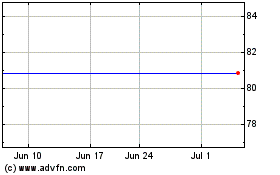UPDATE: St Jude Medical 2Q Profit Falls 5.2% On Charges
July 20 2011 - 12:53PM
Dow Jones News
St. Jude Medical Inc.'s (STJ) second-quarter earnings fell 5.2%
on acquisition and restructuring charges while revenue got a boost
from currency-aided international sales, but also reflected a
weakened U.S. market for heart-rhythm devices.
The St. Paul, Minn., company lowered its full-year guidance to
reflect this weakness, which more than offsets an improved outlook
in other product areas. Wall Street analysts were anticipating a
more troubled environment for heart-rhythm sales based on signs of
market struggles in recent months.
St. Jude hadn't forecast these issues back in April, when it
raised guidance after its first-quarter report, but Chief Executive
Daniel Starks said Wednesday that factors like economic "malaise"
and an ongoing Justice Department probe of defibrillator implant
practices were dampening sales.
The U.S. heart-rhythm market "fell into a pothole during the
second quarter," Starks told analysts on a conference call. "A
pothole by definition is finite, and we will climb out."
The company expects to continue taking market share from
competitors Boston Scientific Corp. (BSX) and Medtronic Inc. (MDT),
but now believes the global heart-rhythm market--which includes
pacemakers and defibrillators--will contract by 2% this year. That
translates to a $11.4 billion market, $500 million less than St.
Jude assumed in April.
St. Jude shares recently traded up 1.8% to $47.68. They had
declined about 8% in a three-month span through Tuesday's close as
investors fretted about a worsening market, and Wednesday's
guidance cut "resets the bar and removes an investor overhang,"
Collins Stewart analyst Tao Levy said.
St. Jude reported a second-quarter profit of $240.9 million, or
72 cents a share, down from $254 million, or 77 cents a share, a
year earlier. Excluding charges, earnings were up at 85 cents from
79 cents. Analysts surveyed by Thomson Reuters had projected
earnings of 84 cents.
The restructuring includes moving heart-rhythm manufacturing out
of Sweden and into Malaysia and Puerto Rico, where costs are
cheaper.
Revenue rose 10% to $1.45 billion, about matching Wall Street
expectations. St. Jude, which now generates most sales outside the
U.S., got a $75 million boost from favorable currency rates.
While international sales surged, U.S. sales were down 2%,
reflecting the heart-rhythm struggles. St. Jude's U.S.
defibrillator sales tumbled 9%, and were still down 5% when
factoring in a one-time benefit last year when Boston Scientific
had a temporary sales halt due to regulatory paperwork issues.
Domestic pacemaker sales were also weak, falling 8%. St. Jude
Chief Financial Officer John Heinmiller noted comparisons with a
strong quarter last year, when the company may have seen a
carryover benefit from Boston Scientific's defibrillator
troubles.
On the defibrillator front, Starks said more St. Jude customers
were contacted by the Justice Department in the second quarter
regarding an ongoing probe into reimbursement submissions than in
prior periods, weighing on sales. This probe appears focused on
doctors and hospitals, Heinmiller said, and questions about whether
implants met guidelines. The government foots the bill for many
patients through Medicare.
St. Jude's heart-rhythm business could get a lift when then
company launches heart-failure defibrillator systems featuring a
new type of cable for connecting devices to the heart. The company
on Wednesday said it now anticipates FDA approval early in the
fourth quarter, rather than its previous estimate for mid-year
approval.
Starks said the sales organization and product inventory are
set, "and we are prepared to initiate a full launch of these
products within days of receiving FDA approval."
Elsewhere, sales of devices for treating the common rhythm
disorder atrial fibrillation surged 18% in the second quarter while
sales of cardiovascular devices, helped by an acquisition last
November, jumped 35%.
St. Jude raised full-year sales forecasts for these businesses,
but that wasn't enough to offset degraded expectations for the
heart-rhythm market. The company lowered its overall 2011 sales
guidance to a range of $5.61 billion to $5.73 billion, down from a
raised forecast in April of $5.69 billion to $5.85 billion.
The company also lowered its 2011 earnings guidance by three
cents to $3.25 to $3.30, reversing April's three-cent guidance
boost. For the current quarter, the company projected per-share
earnings of 74 cents to 76 cents, below views of analysts polled by
Thomson Reuters for 80 cents.
-By Jon Kamp, Dow Jones Newswires; 617-654-6728;
jon.kamp@dowjones.com
--Tess Stynes contributed to this article.
SJM (NYSE:STJ)
Historical Stock Chart
From Jun 2024 to Jul 2024

SJM (NYSE:STJ)
Historical Stock Chart
From Jul 2023 to Jul 2024
